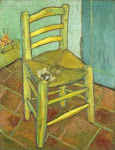At the Historical Novel Society conference last week, whenever the subject of research came up in a panel, the Internet was not far behind. All the authors agreed: the Internet brings a whole new dimension to novel research (or any research), not to mention convenience. And it's true -- as much as I stress to my students the importance of libraries and 'real books' for their essays and pooh-pooh Wikipedia, there is plenty of value to be found online, information that can be trusted and used. For "Sunflowers," I found many scholarly articles online via JSTOR (a subscription only site that I get through the university), and sites like the Van Gogh Gallery saved a lot of time. Google Books has a number of out-of-copyright nineteenth-century goodies scanned into its database, including old French guidebooks and even Salon catalogues. Museum websites nowadays tend to be very informative and provide bibliographic and provenance information for their collections. You can even access nineteenth-century New York Times articles online!
But sometimes what you need can be found in unexpected places. To give a couple of examples: I found a short but helpful video on an absinthe distributor's website demonstrating the nineteenth-century way of mixing absinthe. I had read a description, but seeing the video made a big difference (at that time absinthe was still illegal here, so there was no buying some to mix it myself). Another example: I wanted to describe a Spanish-style bullfight (corrida) in the amphitheater of Arles. When I went to Arles, I saw the amphitheater, I walked up to the top, but no bullfights were scheduled during my trip. Nearby Nîmes has a gallery of toreador costumes in its amphitheater, so I saw those, but had missed by a few days their sequence of corridas for the city's yearly festival. Reading a description wasn't giving me the vividness I sought: what to do? One word--YouTube. I searched 'bullfight Arles' and found amateur videos that helped fill in missing details.
There are even ways to help you get inside a character's emotions using the Internet. In "Sunflowers," Rachel experiences things that I have never come close to experiencing myself -- one event in particular (and I don't mean the 'ear incident') made me wonder how 'real women' cope. So I went online and found a forum dedicated to it. I read real women's stories, and while I didn't use any specific one as inspiration for Rachel's experience, reading the posts helped me understand and capture what she would be feeling.
Not everything on the Internet can be considered a reliable source, of course, and this is the skill I stress to my students: learning to discern what's good and what's not. But there's no shortage of places to look, and who knows what you might discover?
Subscribe to:
Post Comments (Atom)






1 comment:
Great post! Looks like we've both had research resources on our minds. Me, early-modern resources. You, a bit later. Let me know if you ever want to combine forces or posts! :)
Holly
http://www.wondersandmarvels.com
Post a Comment